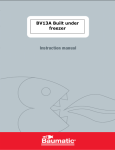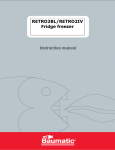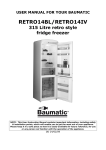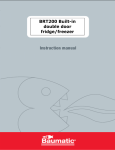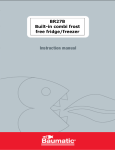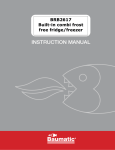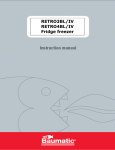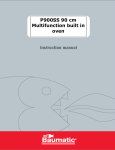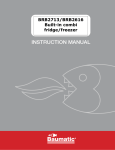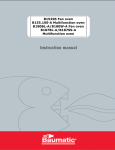Download Baumatic BFB230SL User manual
Transcript
BFB230SL/BFB230W 230 Litre frost free fridge freezer USER MANUAL FOR YOUR BAUMATIC BF230SL/BFB230W 230 Litre frost free fridge freezer NOTE: This User Instruction Manual contains important information, including safety & installation points, which will enable you to get the most out of your appliance. Please keep it in a safe place so that it is easily available for future reference, for you or any person not familiar with the operation of the appliance. DD 22/12/08 2 Contents Environmental note 4 Important safety information 5–6 Specifications of your fridge freezer Description of the appliance Description of the product features 7-9 8 9 Using your Baumatic fridge freezer Before switching on During first use Switching on the appliance and setting the thermostat 10-12 10 10 11-12 Arranging and storing food in the fridge section 12-13 The freezer compartment Freezing fresh food Tips on freezing Making ice cubes Normal operating noises 13 14 14-15 15 15-16 Cleaning and maintenance The defrost drain hole The evaporating tray Defrosting the freezer compartment Replacing the light bulb 16-20 17 18 19-20 20 Installation Electrical connection Positioning Reversing the doors 21-27 21 22 23-27 Troubleshooting 28-29 Contact details 30 3 Environmental note Note: Before discarding an old appliance, switch off and disconnect it from the power supply. Cut off and render any plug useless. Cut the cable off directly behind the appliance to prevent misuse. This should be undertaken by a competent person. Disable the door lock to make sure that children cannot get stuck inside the appliance. o The packaging materials that Baumatic uses are environmentally friendly and can be recycled. o Please discard all packaging material with due regard for the environment. 4 Important safety information Your safety is of the utmost importance to Baumatic. Please make sure that you read this instruction booklet before attempting to install or use the appliance. If you are unsure of any of the information contained in this booklet, please contact the Baumatic Advice Line. IMPORTANT: Any installation work must be carried out by a qualified electrician or competent person. Use of the appliance o Your appliance is only designed to be used in the home. It is suitable for storing food that needs to be chilled and refrigerated. If it is used for any other purpose or it is not used correctly, then Baumatic Ltd. will accept no liability for any damage that is caused. o Altering the specification of the appliance must not be attempted for reasons of safety. Before using your appliance o Check the appliance for any signs of transport damage. If you notice any damage, then you should not connect your appliance to your mains supply and should contact your retailer. Refrigerant o Your appliance contains R600a refrigerant, which is a natural gas that does not contain CFCs that can damage the environment. However it is a flammable substance, therefore care should be taken: During the transportation and installation of the appliance, make sure that the refrigeration pipework does not get damaged. If it does become damaged then sources of ignition and open flames should be avoided. Also the room that the appliance is situated in should be thoroughly ventilated. o Do not place any objects on top of the appliance, as this may damage the table top. 5 Child safety o Packaging material should be kept away from children. o Children should not be allowed to touch the controls or play with the appliance. General safety o Do not pull on the power supply cable to remove the plug from your mains supply socket. o Do not pull out or insert the plug with wet hands. o Do not attempt to use your appliance outdoors or any place where it is likely to come into contact with the elements. o Before cleaning the appliance or performing maintenance work, ensure that the appliance has been disconnected from your mains supply. o Never allow the back coils of the appliance to come into contact with the wall surface. o Always ensure that the location where you are installing your appliance is free of stored items such as papers and other flammable materials. o Never block the ventilation openings of the appliance, either on the inside or its exterior. o It is vital to keep your appliance well ventilated, so that there is proper air flow between the bottom of the unit and the plinth/kick plate which it is sitting on. o Do not place electrical devices inside of the appliance, such as mixers or ice cream makers. Service You should not attempt to repair the appliance yourself, as this could cause injury or a more serious malfunction. If you require a service call then please contact the Baumatic Service Department. 6 Specifications of your fridge freezer Congratulations on purchasing a Baumatic fridge freezer o o o o o Total gross/net capacity: Gross capacity (fridge/freezer): Net capacity (fridge/freezer): Energy efficiency class: Freezer star rating: 263/230 litres 159/104 litres 152/78 litres A **** o o o o o o o o o o Adjustable thermostat Automatic defrost (fridge and freezer sections) 3 x Safety glass shelves 2 x Salad crispers Bottle rack Egg rack Butter and cheese compartment 3 x Transparent freezer drawers Ice cube tray Reversible doors Dimensions of appliance Height: Width: Depth: 1660 mm 540 mm 600 mm * Please refer to the installation instructions for more specific information on the size of aperture that you will require. IMPORTANT: When you install your appliance it is important to bear in mind its climatic rating. In order to find out the climatic rating of your appliance, you should check the rating plate. The rating plate is located on the front edge of the inside of the fridge section, behind the salad drawers. You will need to open the fridge door of your appliance to be able to find it. The rating plate will indicate the ambient temperature range that your appliance will function correctly within. Model number ……………………………………………………………………… Serial number ……………………………………………………………………… Date of purchase ……………………………………………………………………… 7 Description of the appliance 1) Fridge shelf 2) Cooling plate 3) Salad crisper cover 4) Salad crispers 5) Upper freezer drawers (for freezing) 6) Lower freezer drawer (for storage) 7) Kick plate 8) Control panel (including thermostat dial) 9) Full width door shelf 10) Half width adjustable door shelves 11) Bottle shelf 12) Freezer compartment 8 Description of the product features 1) Shelves o The shelves may be placed in any of the guide slots within the interior of the appliance. They are protected from sliding out. o To remove a shelf: Take off all of the items that are stored on the shelf that you want to remove. Then lift the front of the shelf and carefully pull it out of the grooves. 2) Defrost water outlet o The interior of the refrigerator is cooled by the cooling plate that is on the rear wall. Beneath this there is a channel and an outlet for the defrost water. o It is important that this channel never becomes clogged, see “The defrost drain hole” section for a detailed explanation of how to keep the channel clear. 3) Crisper drawer and cover o The crisper drawer is in the bottom of your refrigerator and there is a cover that goes over it. o The cover helps to prevent fruit and vegetables from drying out prematurely. 4) Upper door shelves o The door liner holds various shelves, which are suitable for storing eggs, cheese, butter and yogurt. As well as smaller packages, tubes, cans etc. 5) Bottle shelf o The lower shelf should be used for storing reasonably sized bottles. o IMPORTANT: IT IS IMPORTANT THAT NONE OF THE SHELVES THAT SIT IN THE DOOR ARE OVERLOADED, AS THIS WILL DRASTICALLY REDUCE THEIR WORKING LIFE. 6) Freezer compartment o A freezer section, with a net capacity of 78 litres. 9 Using your Baumatic fridge freezer Before switching on o Make sure that it has been installed by a suitably qualified person, as per the information contained in Baumatic’s installation instructions. o After delivery, wait for eight hours before connecting the appliance to your mains supply. This will allow any refrigerant gasses that may have been disturbed during the transportation process to settle. o The outside of the appliance and the removable accessories contained within it, should be cleaned with a solution of liquid detergent and water. o The interior of the appliance should be cleaned with a solution of sodium bicarbonate dissolved in lukewarm water. The interior and accessories should be thoroughly dried, after the cleaning process has been completed. o There can be an odour when you first switch on the appliance. It will lessen as the appliance starts to cool. During first use o When you first switch on the appliance, the compressor will run continuously for approximately 24 hours or until the fridge freezer reaches a cool enough temperature. o With dry hands, connect your appliance to your mains supply. Set the thermostat control knob to the position <6> for a 24 hour period, before positioning it to the normal setting of between position <3> and <4>. o During this period of time, you should try not to open the door frequently or place a large amount of food within the appliance. o If the unit is switched off or unplugged, you must allow at least 5 minutes before restarting the appliance on the thermostat or reconnecting it to your mains supply. 10 Switching on the appliance and setting the thermostat You switch on your appliance by connecting it to your mains supply and setting the thermostat. The thermostat dial is located on the control panel. o The thermostat automatically regulates the temperature inside the fridge freezer, depending on what number you have turned the thermostat dial to. You may require a coin to turn the thermostat dial. o If you set the thermostat dial below position <1>, then the appliance will not cool, but the internal light will still function. o Position <1> will give you a higher temperature inside the fridge freezer. o Position <6> will give you a lower temperature inside the fridge freezer. o Ideally the thermostat should be set to a position between <3> and <4>. o The fridge section can maintain a temperature of between 4 – 6 degrees centigrade. o The freezer section can cool down to -18°C and lower. o IMPORTANT: The ambient temperature of the room, the temperature of food and the amount of food that has been placed in the fridge freezer and how often the door is opened, will all affect the temperature being maintained by the appliance. o On the maximum setting (position <6>), your fridge freezer will work harder to maintain a lower temperature. There is no need to run your appliance on setting <6> for prolonged periods. Unless you are freezing fresh food, you should have the thermostat knob set to between <3> and <4>. 11 o IMPORTANT: Do not run the thermostat above position <4>, otherwise the defrost drainage hole will freeze. Arranging and storing food in the fridge section o Warm food or evaporating liquids should not be stored in your refrigerator, as this will increase the humidity inside of the appliance. o All foods should be wrapped or covered, this is particularly important if the food has a strong flavour. You should use polythene bags or sheets, aluminium foil, wax paper. Liquids should be stored in covered containers or bottles. o To maximise the space inside of the fridge section, any excessive packaging on the food should be removed. o Quickly perishable food should be stored at the back of the refrigerator, which is the coldest part of the appliance. o No food items should be allowed to come into contact with the back wall of the refrigerator. o Make sure that you arrange food in such a way that the door can close completely. Particular attention should be given to bottles that may protrude when placed on shelves inside the main section of the refrigerator. o Some organic solutions, such as the oils in lemon/orange peel and acid in butter, can cause damage to the plastic parts contained inside of the refrigerator. o Do not open the refrigerator door too often or leave the door open for long periods of time, as this will increase the temperature inside of the appliance. o Meat should be wrapped in polythene bags and then placed on the glass shelf above the salad drawers. (Meat should only be stored in this manner for one or two days at the most). o Cold dishes/cooked food should be covered and can be placed on any shelf. o Fruit and vegetables should be cleaned thoroughly and placed in the salad drawer. 12 o Cheese and butter should be placed in airtight containers, or they can be wrapped in aluminium foil or polythene bags. As much air as possible should be removed from the bags. o Milk bottles should have a cap on them and be stored on the bottle shelf that sits in the door. o Garlic, potatoes, onions and bananas should only be stored in a refrigerator IF they are kept in airtight containers. The freezer compartment The freezer compartment is suitable for storing and freezing food. o The freezer compartment temperature must have already reached -18 degrees centigrade (or lower) before you attempt to store food that is already frozen or freezing fresh food. o The freezer compartment is only able to freeze a certain quantity of food at one time. You should not attempt to freeze more than 3.5 kilograms of fresh food within a 24 hour period. o Preferably the upper freezer drawers (5) should be used when freezing fresh food. Once the food is frozen, you can then transfer the food to the lower freezer drawer (6). o Warm food should be allowed to cool down before you attempt to freeze it. If you place warm food in the freezer compartment, then the increased humidity will cause quicker ice formation and increase the amount of power that the appliance uses. o The guidance of the food manufacturer should be followed, in regard to the maximum storage time. o Thawed foods must not be frozen for a second time. o If power is cut to your appliance, DO NOT open the door to the freezer compartment. Your freezer will store food safely in an ambient temperature of 25°C for approximately 12 hours. o IMPORTANT: If the food has started to defrost before power is restored, then DO NOT re-freeze the items. The food should be used within a relatively short period of time. 13 Freezing fresh food o To freeze the maximum quantity of fresh food specified above, you should turn the thermostat dial to position <6>, 3 hours prior to attempting freezing. o For smaller quantities of fresh food, you should turn the thermostat dial to position <6>, approximately 1 hour prior to attempting freezing. o Fresh food should be packed into airtight containers or packaging. This will help to make sure that the food doesn’t dry out or lose its flavour. It will also ensure that flavour does not transfer from other foods. o The food should be placed on the freezer compartment’s base. Do not allow fresh food to touch items that are already frozen. o After 24 hours you should check that the fresh food is satisfactorily frozen. If it is then the thermostat dial should be turned down to its normal setting (between <2> and <4>). Tips on freezing o Freezer bags, polythene wraps, aluminium foil (extra thick) and special cans for frozen foods are suitable packaging for storing frozen goods in. o Tape, rubber bands or plastic clips are suitable for sealing bags and wrappings. o Before sealing a suitable bag, you should compress the air out of it, as this will help the food to freeze more easily. o Flat packages freeze more easily. 14 o If you are freezing liquid, then do not fill the container to the brim. Liquids will expand when being frozen. o Do not place bottles (glass or tin) containing liquids (especially sparkling liquids) into the freezer as they could cause the bottle to burst during freezing. Making ice cubes o Fill the ice cube tray with water and place it in the upper freezer drawers (5). o After the water is completely frozen and turned to ice, you can twist the ice cube tray (as shown in the drawing below) to dispense the ice. Normal operating noises Ice cracking noise o Can be heard during the automatic defrosting process. o Can be caused by expansion and contraction within the fridge freezer. Short cracking noise o Can be heard when the thermostat turns the compressor on and off. Compressor noise o There will be an operating noise when the compressor is running. o After installation, the compressor maybe noisier for a short period of time. Bubbling and burbling sound o This noise is emitted as the coolant flows through the pipework within the fridge freezer. 15 Water flowing sound o This is caused by water flowing into the evaporating tray during the defrosting process and can be heard whilst the fridge freezer is defrosting. Water blowing sound o This is caused by a fan operating to allow air to circulate around the cabinet. This is what makes the appliance a frost free. Cleaning and maintenance WARNING: PLEASE ENSURE THAT YOUR APPLIANCE IS DISCONNECTED FROM YOUR MAINS SUPPLY BEFORE ATTEMPTING TO CLEAN IT. o Do not clean the appliance by pouring water onto it or spraying water over it. o The refrigerator and freezer compartment should be cleaned periodically, using a solution of bicarbonate of soda and lukewarm water. o Clean the accessories separately with soap and water. Do not clean them in a dishwasher. o Do not use abrasive products, detergents or soaps. o After washing the appliance, wipe over the area that you have cleaned with a damp cloth and then dry it thoroughly. o When cleaning is complete, dry your hands and then reconnect the plug to your mains supply. 16 The defrost drain hole o Defrosting occurs automatically in the refrigerator compartment during operation. The defrost water is collected by the evaporating tray and evaporates automatically. o The drain hole should be cleaned periodically with the drain hole cleaner. This will prevent water from collecting in the bottom of the refrigerator, instead of flowing down the defrost drainage channel and drain hole. o IMPORTANT: Please note that the drain hole cleaner should not be left in position permanently. Otherwise this may prevent the defrost water from entering the drain hole. o You can also pour a small amount of water down the drain hole to clean the defrost drainage channel. o You should be careful to make sure that food packages do not touch the rear wall of the appliance, as this can interrupt the automatic defrosting process and deflect water into the base of your refrigerator. o Use a solution of bicarbonate of soda and lukewarm water to clean the evaporating tray. o IMPORTANT: It is normal to get some ice droplets forming on the back wall of the appliance. The formation of ice droplets does not indicate an appliance fault. 17 The evaporating tray o The evaporating tray at the rear of the appliance can be removed for cleaning purposes. o IMPORTANT: PLEASE ENSURE THAT YOUR APPLIANCE IS DISCONNECTED FROM YOUR MAINS SUPPLY BEFORE ATTEMPTING TO CLEAN THE EVAPORATING TRAY. o To remove the evaporating tray you should unscrew the two fixing screws that hold it in position (as indicated in the above diagram). o IMPORTANT: CARE SHOULD BE TAKEN WHEN REMOVING THE EVAPORATING TRAY, AS THE COMPRESSOR THAT IT SITS ON GETS EXTREMELY HOT DURING OPERATION. o The evaporating tray should be cleaned using a solution of bicarbonate of soda and lukewarm water. o The evaporating tray should be dried thoroughly before being reattached to the appliance. o IMPORTANT: THE EVAPORATING TRAY MUST BE REATTACHED OTHERWISE DEFROST WATER WILL RUN ONTO THE COMPRESSOR AND THE FLOOR UNDERNEATH THE APPLIANCE. 18 Defrosting the freezer compartment Your appliance is frost free, so you will not normally need to manually defrost the freezer compartment. However if for example the door is left open for a prolonged period of time or the door gasket is not sealing correctly, then you could get ice building in the freezer section. If this occurs, then you should follow the steps below. o The day before you defrost, the thermostat dial should be turned to position <6>; this will make sure that the food contained in the compartment is frozen properly. o Whilst defrosting the appliance, the food should be removed from the compartment and wrapped in several layers of paper and stored in a cool place. The foods rise in temperature will shorten its storage life and therefore the food should be used within a relatively short period of time. o DO NOT PLACE FOOD BACK IN THE FREEZER COMPARTMENT THAT HAS STARTED TO THAW. o After ensuring that your hands are dry, disconnect your fridge freezer from your mains supply o Remove the drawers from the freezer section and leave the door to the freezer compartment open. You can place a bowl of warm water inside of the freezer compartment to speed up the defrost process. o You can use a sponge to mop up the defrost water that will run into the bottom of the freezer compartment. o IMPORTANT: You should place some old towels on the flooring that is immediately in front of the appliance; in case any defrost water comes out of the freezer compartment and onto the floor. o Once all the ice that has built up has melted, then the inside of the freezer compartment should be dried thoroughly. Failure to do this will result in immediate ice build when the appliance is switched back on. o With dry hands, reconnect your appliance to your mains supply. Set the thermostat control knob to position <6> for a 24 hour period, before returning it to the normal setting of between position <3> and <4>. 19 o You should not attempt to freeze fresh food inside the freezer compartment until this 24 hour time period has elapsed. o Do not defrost the appliance with other electrical devices (e.g. hair dryer). Do not use sharp metal objects to remove the ice from the freezer, as this could cause damage to the refrigerant system. Replacing the light bulb WARNING: PLEASE ENSURE THAT YOUR APPLIANCE IS DISCONNECTED FROM YOUR MAINS SUPPLY BEFORE ATTEMPTING TO REPLACE THE LIGHT BULB. o There is an interior light in the roof of the refrigerator compartment. o Use a screwdriver to remove the cover that goes over the lightbulb. o Change the present light bulb with a new one. The replacement bulb should not have a greater rating than 15 W. o Replace the light cover and after waiting five minutes, reconnect your plug to your mains supply. 20 Installation IMPORTANT: Before installation and usage read all the instructions and make sure that the voltage (V) and the frequency (Hz) indicated on the rating plate are exactly the same as the voltage and frequency in your home. The rating plate can be found on the front left edge of the inside of the refrigerator. The manufacturer declines all responsibility in the event of the installer failing to observe all the accident prevention regulations in force, which are necessary for normal use and the regular operation of the electric system. Electrical connection YOUR FRIDGE FREEZER IS INTENDED FOR FITTED AND PERMANENT INSTALLATION. We recommend that the appliance is connected by a qualified electrician, who is a member of the N.I.C.E.I.C. and who will comply with the I.E.E. and local regulations. o Your refrigerator comes supplied with a 13 amp plug fitted. If in future you need to change the fuse in this plug, then a 13 amp ASTA approved (BS 1362) fuse must be used. o The wiring in the mains lead is coloured as follows: Brown Live Blue Neutral Green and yellow Earth o As the colours of the wires in the appliance’s mains lead may not correspond with the coloured markings identifying the terminals in your spur box, please proceed as follows: The brown wire must be connected to the terminal marked “L” (live), or coloured red. The blue wire must be connected to the terminal marked “N” (neutral), or coloured black. The green and yellow wire must be connected to the terminal marked “E” (earth), or by the earth symbol, or coloured green and yellow. o When the connection is completed, no stray strands or cut wire should be present. The cord clamp must be secured over the outer sheath. 21 Positioning o It is advisable that your appliance is only installed in a location where the ambient temperature of the room, corresponds with the climate classification that is stated on the rating plate of your appliance. Your appliance may not function correctly if the ambient temperature falls outside of the following ranges. Climate classification Appropriate ambient temperature SN +10 to +32 degrees centigrade N +16 to +32 degrees centigrade ST +18 to +38 degrees centigrade T +18 to +43 degrees centigrade o Positioning the appliance requires two people in order to avoid injuries or damage to the appliance. o Your appliance should not be located in direct sunlight or exposed to continuous heat or extremes of temperature (e.g. next to a radiator or boiler). If this is not possible, then you should install an insulation plate between the appliance and the adjacent heat source. o You should check whether there is an electrical socket available, which will be accessible after your appliance is installed. o Place the appliance flatly and firmly on a solid base. The appliance is fitted with adjustable feet on the front side, which can be used to level the appliance. o Anything positioned above the appliance must be at least 15 cm away to allow sufficient cooling of the condenser. You must allow a 5 cm gap to the rear and either side of the appliance. o If you are placing another cooling appliance next door to this product, then there must be a gap of at least 2 cm between the appliances. This will help to prevent condensation from forming. o Be sure to leave enough space for the opening of the door, to avoid damage to the appliance or personal injury. 22 Reversing the doors IMPORTANT: Make sure you have enough room to lay the appliance on its side, care should be taken not to damage or break the condenser coils on the rear of the fridge freezer. You should also ensure that there are no sharp or hard objects on the floor in this area. THE APPLIANCE MUST BE DISCONNECTED FROM THE POWER SUPPLY BEFORE COMMENCING THE DOOR REVERSAL PROCESS. CERTAIN SECTIONS OF THIS PROCESS WILL REQUIRE TWO PEOPLE TO COMPLETE IT. Any parts that you remove from the appliance whilst reversing the door, should be retained for later use. 1. Open the fridge door and remove the two fixing screws that go through the right hand hinge. o Also remove the two middle hinge screw caps on the left hand side of the cabinet. 23 2. Carefully remove the fridge door and freezer doors, by pulling them away from the cabinet. o The middle hinge should also be removed from the cabinet at this point. o Both of the doors should be gently placed on some form of padded surface, so that damage is not caused to them. 3. On the underneath of the appliance (right hand side), there is an adjustable foot. On the underneath of the appliance (left hand side), there is an adjustable foot and a bottom hinge fixing. o Carefully lay the appliance down on its left hand side. o Unscrew the bottom hinge fixing and remove it. Then unscrew both of the adjustable feet. 4. Remove the hinge pin from the bottom hinge and screw it into the left hand hole in the bottom hinge. o Fit the bottom hinge fixing to the left hand side of the fridge freezer (the opposite side to its original position). o Replace both of the adjustable feet. o Carefully return the appliance to an upright position. 24 5. Fit the two middle hinge screw caps into the holes on the right hand side of the cabinet. 6. Unscrew the pin from the top right hinge (A) and screw it into the top left hinge (B) 7. Remove the top screw hole plug from the left hand side of the refrigerator door. o Transfer the bush from the top right hand corner of the refrigerator door, into the hole on the top left hand corner of the refrigerator door. o Swap the bush on the bottom right hand corner of the refrigerator door to the opposite side. 25 8. Remove the top screw hole plug from the left hand side of the freezer door. o Transfer the bush from the top right hand corner of the freezer door, into the hole on the top left hand corner of the freezer door. o Swap the bush on the bottom right hand side of the freezer door to the opposite side. 9. Turn the middle hinge 180° from its original position and then fix it to the left hand side of the cabinet using the original screws. These screws must be fully tightened. o Re hang the fridge and freezer doors onto the cabinet. 26 o IMPORTANT: You must ensure that all of the hinge pins locate into the relevant holes in the fridge and freezer doors. Also the washers that fit over the hinge pins must also be present. IMPORTANT: Check that both the upper and lower doors open and shut correctly, without fouling, after you have completed the door reversal process. After the door has been reversed, you should check the door seal of the fridge and freezer door. Neither seal should be creased or crushed; otherwise there will be a gap between it and the inside of the door. o The seal must adhere properly all the way around the door. o If either seal is not adhering to the cabinet properly, then you should either:1. Use a warm damp cloth and manipulate the seal until it does adhere to the cabinet properly, all the way around the door. or 2. Use a hair dryer on its lowest heat setting and lightly heat the areas of the door seal that are not adhering correctly. The heat will make the seal more pliable and this will allow you to manipulate the seal into the correct position. IMPORTANT: DO NOT HEAT THE DOOR SEAL ON ANYTHING BUT THE LOWEST HEAT SETTING, OR HEAT THE SEAL FOR A LONG PERIOD OF TIME. OTHERWISE DAMAGE MAY BE CAUSED TO THE DOOR SEAL, WHICH WOULD NOT BE RECTIFIED UNDER THE GUARANTEE FREE OF CHARGE. IMPORTANT: WHEN YOU HAVE REVERSED THE DOORS OF THE APPLIANCE. AS YOU HAVE PLACED THE APPLIANCE ON ITS SIDE, YOU MUST WAIT FOR 8 HOURS BEFORE SWITCHING THE APPLIANCE BACK ON. 27 Troubleshooting IMPORTANT: If your fridge freezer appears not to be operating properly, before contacting the Baumatic Service Department, please refer to the checklist below. My fridge freezer does not appear to be working/there is no power to my appliance. o Check that the plug is fully inserted into the power socket. o Check that there is power to your mains supply (e.g. that there hasn’t been a power cut or that the fuse hasn’t blown). o Check that the thermostat dial has not been turned to the off position. o Check that your mains supply voltage, corresponds to the voltage stated on the rating plate of your appliance. My fridge freezer appears to be performing poorly o Check that the appliance isn’t overloaded and that food hasn’t been packed too tightly into it. o The thermostat setting is too low; you should turn the thermostat dial to a higher number. o Ensure that the doors are closing properly and that the doors have not been opened for a prolonged period in error. o Ensure that there is adequate ventilation for your appliance. My fridge freezer is noisy o The refrigerant gas that circulates the pipework of the appliance may make a slight noise, even if the compressor is not running. o If the noise worsens or the appliance gets louder than normal; check that it is levelled off correctly, that nothing is touching the rear of the fridge freezer and that nothing placed inside the appliance is rattling. 28 Ice has formed on the inner back wall of my fridge o Check that food has not been pushed too far back inside the appliance, so that it is in contact with the inner back wall. o IMPORTANT: It is normal to get some ice droplets forming on the back wall of the appliance. The formation of ice droplets does not indicate an appliance fault. There is water in the base of the fridge or leaking out of my fridge. o Follow the “The defrost drain hole” section on page 17. IMPORTANT: If your appliance appears not to be operating correctly, then you should disconnect it from your mains supply and then contact the Baumatic Service Department on telephone number (0118) 933 6911. DO NOT ATTEMPT TO REPAIR THE APPLIANCE YOURSELF. Please note that if an engineer is asked to attend whilst the product is under guarantee and finds that the problem is not the result of an appliance fault, then you may be liable for the cost of the call out charge. The appliance must be accessible for the engineer to perform any necessary repair. If your appliance is installed in such a way that an engineer is concerned that damage will be caused to the appliance or your kitchen, then he will not complete a repair. This includes situations where appliances have been tiled in, sealed in with sealant, have wooden obstructions placed in front of the appliance, like plinths. Or any installation other than the one specified by Baumatic Ltd. has been completed. Please refer to the conditions of guarantee that appear on the warranty card that you receive with the appliance. 29 United Kingdom Baumatic Ltd., Baumatic Buildings, 6 Bennet Road, Reading, Berkshire RG2 0QX United Kingdom Sales Telephone (0118) 933 6900 Sales Fax (0118) 931 0035 Service Telephone (0118) 933 6911 Service Fax (0118) 986 9124 Spares Telephone (01235) 437244 Advice Line Telephone (0118) 933 6933 E-mail: [email protected] [email protected] Website: www.baumatic.co.uk Republic of Ireland 01- 6266 798 Czech Republic Baumatic CR spol s.r.o. Amperova 495 46215, Librec Czech Republic +420 800 185 263 www.baumatic.cz Slovak Republic Baumatic Slovakia, s.r.o. Skultetyho 1 831 04 Bratislava 3 Slovakia +421 255 640 618 Germany Baumatic Gmbh Janderstrasse 9 Mannheim, 68199 Germany +4962 112 9190 www.baumatic.de Italy Baumatic Italia S.R.L. Via Caltana 129 Campodarsego (Padova), 35011 Italy +3904 9920 2297 www.baumatic.it Holland Baumatic Benelux B.V. Grindzuigerstraat 22 1333 MS ALMERE The Netherlands +3136 549 1555 www.baumatic.nl 30 31 32
































